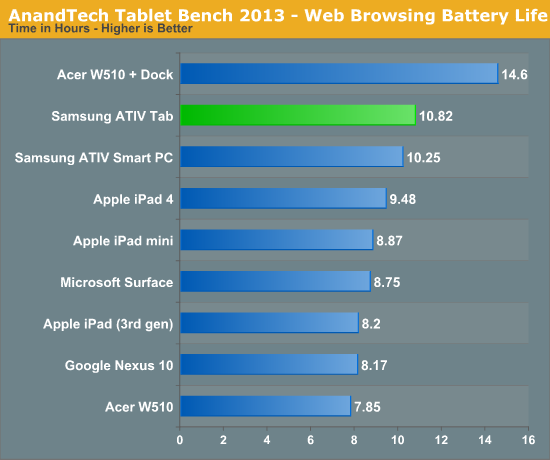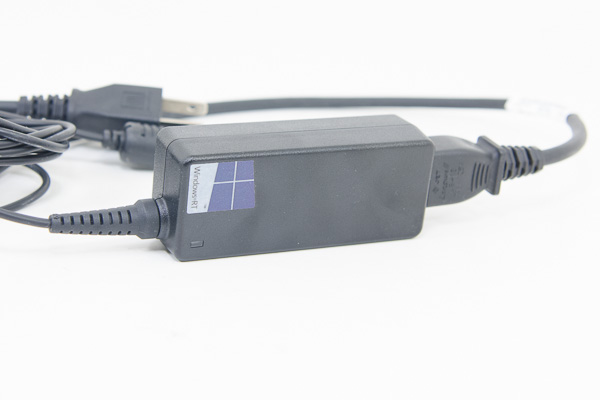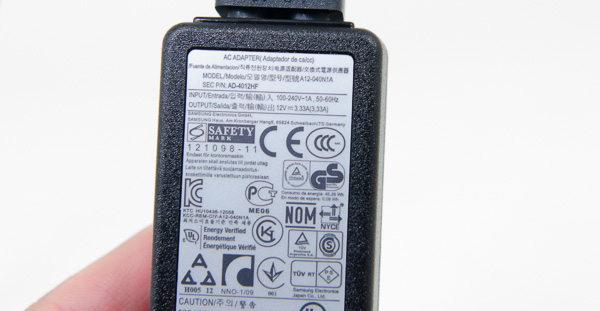Samsung ATIV Tab Review: Qualcomm's First Windows RT Tablet
by Anand Lal Shimpi on January 3, 2013 6:00 AM EST- Posted in
- Tablets
- Samsung
- Qualcomm
- Mobile
- Windows RT
Charging & Battery Life
The ATIV Tab ships with a two piece power adapter that looks a lot like what you'd get with a Samsung notebook. The adapter is rated for 3.33A at 12V, but in practice it'll draw a max of 11.3W while charging (but not powering) the ATIV Tab.
The power supply must be fairly inefficient because even after 2.68 hours of pulling over 10W, the ATIV Tab's 30Wh battery is only 68% charged. After 3.44 hours the battery was at 85% of its fully charged capacity and it's not until 5.25 hours before the ATIV Tab will report being fully charged (after 4.5 hours it only has around 5% left to go).
The good news is that using the ATIV Tab while charging it doesn't appear to slow charge times down at all. The ATIV Tab is limited to pulling ~11W from the wall while charging, but if you're using the tablet while charging the power adapter will draw several more watts.
Battery Life
We've started running our new smartphone web browsing battery life test on tablets as well. If you missed its introduction in our iPhone 5 review, here's a bit about the new test:
We regularly load web pages at a fixed interval until the battery dies (all displays are calibrated to 200 nits as always). The differences between this test and our previous one boil down to the amount of network activity and CPU load.
On the network side, we've done a lot more to prevent aggressive browser caching of our web pages. Some caching is important otherwise you end up with a baseband/WiFi test, but it's clear what we had previously wasn't working. Brian made sure that despite the increased network load, the baseband/WiFi still have the opportunity to enter their idle states during the course of the benchmark.
We also increased CPU workload along two vectors: we decreased pause time between web page loads and we shifted to full desktop web pages, some of which are very js heavy. The end result is a CPU usage profile that mimics constant, heavy usage beyond just web browsing. Everything you do on your device ends up causing CPU usage peaks - opening applications, navigating around the OS and of course using apps themselves. Our 5th generation web browsing battery life test should map well to more types of mobile usage, not just idle content consumption of data from web pages.

Battery life for the ATIV Tab is amazingly good. With a smaller display but the same sized battery, the Qualcomm powered tablet is able to best Intel's Clover Trail powered ATIV Smart PC. The display discrepancy makes drawing a direct conclusion here difficult, but we'll soon be able to repeat our Clover Trail power experiments with a Krait based tablet to see how close those two SoCs really are when it comes to power consumption.
At 10.82 hours off of a 30Wh battery, the ATIV Tab does better than even the 4th generation iPad.
Our video playback test remains unchanged from previous tablet reviews. Here I'm playing a 4Mbps H.264 High Profile 720p rip I made of the Harry Potter 8 Blu-ray. The full movie plays through and is looped until the battery dies. Once again, the displays are calibrated to 200 nits:

Video decode battery life is outstanding from the ATIV Tab - we finally have a tablet that can equal Apple's iPad in terms of battery life when playing back video. There's a clear advantage here over the Clover Trail based platforms, and obviously compared to the Tegra 3 based Surface RT as well. I believe what we're seeing here are the benefits of TSMC's 28nm LP process delivering extremely low leakage while the SoC is mostly idle. Qualcomm's video decode block seems to do a great job at being very power efficient here.













42 Comments
View All Comments
Tech-Curious - Thursday, January 3, 2013 - link
Well said.Especially this bit.
MonkeyPaw - Thursday, January 3, 2013 - link
Actually, once you use a nice high-Res device, it is quite difficult to go back to a cheap panel. My vision is by no means great, but the difference between a TF300T and a TF700T is quite noticeable.More to the current weakness of Windows 8--they need to get auto-correct going. So far, the touch keyboard is just that. MS just seems behind on system-wide text entry advancements.
Tech-Curious - Thursday, January 3, 2013 - link
I'm not saying that a higher resolution can't improve your subjective experience on a very small screen -- but at the screen size we're discussing, the difference is nebulous, undefinable.(The high-res panel might also have better color fidelity or a better contrast ratio, for example. Resolution isn't the only determinant of image quality -- and by definition, resolution becomes less determinant as screen size dwindles.)
High resolution is a luxury, and as BrokenCrayons points out, it's a costly luxury. To me, the benefit of a larger resolution is more than offset by the performance penalty. A tablet with a high-res screen will tend to cost more, and it will tend to age faster than a lower-res analogue. After all, your TF700T has to draw 222% more pixels than your TF300T. (2.28 million versus 1.024 million.)
Do you really think the TF700T looks 222% better? If you'd never used the TF700T, would the display on the TF300T bother you at all? The inferior tablet in your example boasts a pixel density 10% higher than the pixel density of the perfectly serviceable desktop monitor on which I'm typing this post, BTW.
As usual, the matter boils down to a value proposition. Of course a higher-resolution screen is better than a lower-resolution screen, all else being equal, but people on any kind of budget should consider how well a given resolution fits into their budget, both now and in the future. I say the same thing about desktop rigs; if you're a gamer, for example, and you get yourself accustomed to ultra-high-res and/or multi-monitor gaming, then you are signing yourself up for a very expensive hobby. You may only have to buy the monitor(s) once, but you're gonna have to keep shelling out for high-end video cards to accommodate it (them).
On the other hand, someone who is accustomed to (and content with) lower-resolution gaming can wring an immense amount of value out of their computer hardware. Likewise, a consumer who's content with less-than-preposterous resolutions on a tablet will wring more value out of his tablets. He'll feel compelled to upgrade less often, which is probably the reason tablet manufacturers are pushing high-res screens so hard lately. ;)
Tech-Curious - Thursday, January 3, 2013 - link
(That should say, "your TF700T has to draw 122% more pixels than the TF300T." The former has 222% as many pixels as the latter, not 222% more pixels. :)Tech-Curious - Thursday, January 3, 2013 - link
All of that said, and whether you think a high-res tablet display is worth it or not, I think we can agree that killerclick's original, disparaging comment ("LOL @ 1366x768") was unwarranted given the size of the screen we're discussing.MonkeyPaw - Friday, January 4, 2013 - link
In my search to replace my Iconia A500, I tried a W510, TF300T, and the TF700T. I am normally a value shopper too, but the older I get, the more my definition of value changes. I used my last tablet every day, almost exclusively at home, and I don't play FPS games on a tablet. It's not IF the screen is some quantitative amount better, it is if the clearly better screen is worth the extra cost. Considering you also get faster internals and better build quality for an additional $70, I'd say it's worth it. I didn't find that much variation in battery life, and the TF700T lasts "all day" and charges in a couple hours. I used 5% of my battery in 40 minutes of web browsing this morning.Tech-Curious - Friday, January 4, 2013 - link
I'm glad you're happy with your purchase. To clarify, it was never my intention to criticize the TF700T as a bad value in total. I'm actually a bit of an ASUS fanboy.As you point out, there's more to the product than just the screen's resolution. My only point is that high resolution is a burden on the rest of the system. Like BrokenCrayons, I question how much practical use the consumer gets out of 1900x1200 on a 10.1" screen.
ninjacut - Thursday, January 3, 2013 - link
Its absolutely worth the price, considering it runs a full OS and not a Phone OS. If you compare the footprint, WP8 has same size has Android or iOS.Now add multi-user, desktop, office, file system, network share, with desktop grade utilities like power shell, explorer, task manager, disk manager, etc. etc. etc then obviously the footprint will be large.
Is that too difficult to realize?
mayankleoboy1 - Thursday, January 3, 2013 - link
Anand, both SunSpider and Kraken are outdated benchmarks. Browsers have optimisations for them, which doesnt translate into real world performance.The best benchmark is the "Google Octane". It consist of all real world tests.
DanNeely - Thursday, January 3, 2013 - link
Any idea when this will be finished? We've seen battery results a few weeks ago alongside the Acer 510 review; and you've added CPU/GPU numbers on it in this review. What's left to do before the writeup?